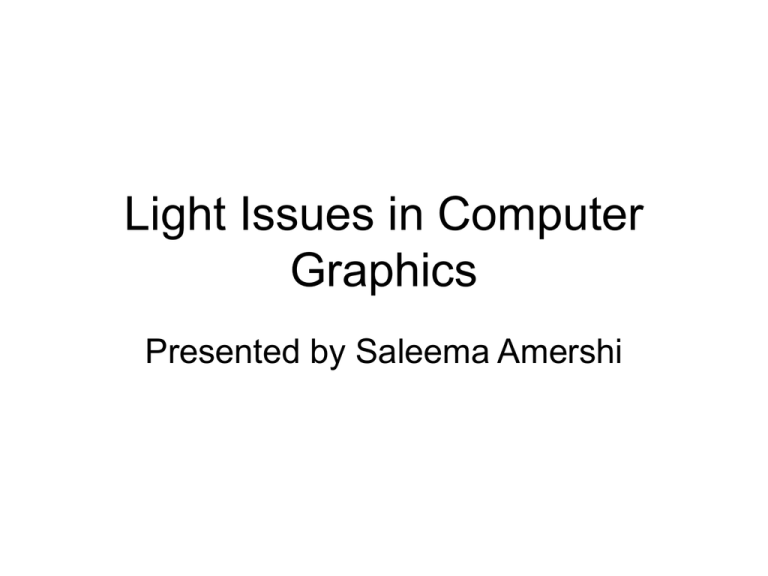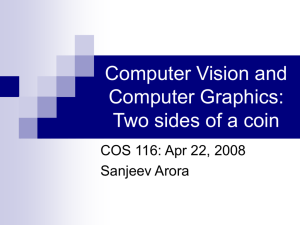Light Issues in Computer Graphics Presented by Saleema Amershi
advertisement

Light Issues in Computer Graphics Presented by Saleema Amershi • Light plays an important part in computer graphics for rendering realistic images. • Using lighting models, we can simulate shading, reflection and refraction of light, comparable to what we see in the real world. • Local illumination refers to direct interaction between one light source and one object surface. • Global illumination refers to the interaction of light between all surfaces in a scene. – Responsible for shading – Reflection between surfaces – Refraction of surfaces Local Illumination Models • In computer graphics, single object-light interaction is approximated through local illumination models. • Basic model used is the Phong model which breaks local illumination into 3 components: – Ambient reflection – Diffuse reflection – Specular reflection • For every point, or small surface area, of an object, we want to calculate the light due to these three components. Ambient reflection • Crude approximation to global effects of light. • Accounts for the general brightness in a scene from light scattering in all directions from all surfaces. • Iout = kambient ∙ Iambient • I is the light intensity (power per unit area), or illumination. Diffuse Reflection • All materials have diffuse properties, due to the ‘roughness’ of a surface at the microscopic level. • Ideal diffuse reflection refers to light hitting a surface and then scattering evenly in all directions due to the surface ‘roughness’. • Lambert said that the energy reflected off a surface from a light source is proportional to the cosine of the incident angle, i, between the light and the normal to the surface. • Iout α cos(i) or Iout α n ∙ l • So now we have – Iout = kambient ∙ Iambient + kdiffuse ∙ Ilight ∙ n ∙ l Specular Reflection • Shiny materials have specular properties, that give highlights from light sources. • The highlights we see depends on our position relative to the surface from which the light is reflecting. • For an ideal mirror, a perfectly reflected ray is symmetric with the incident ray about the normal. • But as before, surfaces are not perfectly smooth, so there will be variations around the ideal reflected ray. • Phong modelled these variations through empirical observations. • As a result we have: Iout = kspecular ∙ Ilight ∙ coss(θ) • s is the shininess factor due to the surface material. Phong Lighting Model • Putting all these components together gives us: Iout = kambient∙Iambient + kdiffuse∙Ilight∙(n∙l) + kspecular∙Ilight∙(v∙r)s • In reality, however, we can have more then one light source reflecting light off of the same surface. This gives us: Iout = kambient∙Iambient + ∑Ilight ∙ (kdiffuse∙(n∙l)+ kspecular∙(v∙r)s ) • Varying shininess coefficient in specular component: • Combining diffuse and specular lighting: diffuse diffuse plus specular How do we use really use this? y=top • Viewing frustrum x=left y VCS x y=bottom z=-near x=right • Z-buffering and the image plane -z Example • No shadows • No refractions or reflections Ray Tracing! • Better method, can show these realistic effects. Ray Tracing Method • Cast a ray from the eye (or the camera) through each pixel in the image plane, until the ray intersects an object. • Calculate local illumination for this point using Phong model. Calculating Intersections • Largest computational overhead. • Most objects are represented by collections of planar polygons. • Intersections are between rays and planes. • Implicit plane equation F(P) = N∙P + D =0 • Parametric ray equation P(t) = Pa + t(Pb – Pa) • Solve for t: F(P(t)) = N∙( Pa + t(Pb – Pa ) + D = 0 t =( -D -N∙ Pa )/( N∙ Pb - N∙ Pa ) • Plug back into P(t) to get intersection point. • Remember that calculating t is solving a quadratic. We want the first intersection of the ray with a surface, so take the smallest t value. • After finding the intersection point, we need to actually see if this point lies within the polygon that described the plane. • Use barycentric coordinates to test (not covered here). • Try to avoid calculating intersections, by testing whether there actually will be an intersection before calculating it. So Whats New? • Need to do more then just calculate the local illumination for the point of intersection to make full use of ray tracing. • Cast secondary reflection and refraction rays from point of intersections to see other effects. Checking for Shadows • For each light source in a scene, cast a ray from that light source to the intersection point we just calculated. • If the ray hits an object before reaching the point, then ignore contributions from that light source. • Add this to local illumination model: Iout = kambient∙Iambient + ∑blightIlight ∙ (kdiffuse∙(n∙l)+ kspecular∙(v∙r)s ) • blight is 0 or 1 depending on whether light is obstructed or not. Refraction • As we all know, lenses, glass, water and other translucent materials refract light. • We can cast a secondary refraction ray from the intersection point if a material is translucent. Snell’s Law! • Computer graphics uses Snell’s law to compute the refracted ray, but in vector form. • Snell’s Law: ni sin(i) = nr sin(r) • Vector form: ni (l x n) = nr (r x n) • Solve for r (complicated derivation) – r = ni / nr (cos(i)) – cos(r)n - ni / nr l = ni / nr (n ∙ l) – √(1- (ni / nr )2 (1 – (n ∙ l) 2 ) * n - ni / nr l • After calculating the direction of the refracted ray, we can cast a secondary ray in this direction and recursively look for intersections and add illumination values from these other intersections to the illumination of the original intersections. • Can do the same for reflected rays off of other surfaces by casting a ray in the direction of reflection as before: r = (2l ∙ n)n - l • These secondary illumination values will not have as much weight on the illumination of the pixel as the original illumination value, as intensity of light decreases as distance increases. • Add a weighting factor to these secondary illumination values to account for this. • Recurse from secondary intersections. The Ray Tracing Algorithm • raytrace(ray from a pixel) -calculate closest intersection -calculate local illumination //take shadows for intersection point //into account -reflected_component = raytrace(reflected_ray) // if an object surface has reflection properties (ie. is //not completely diffuse) -refracted_component = raytrace(refraced_ray) //if an object surface is transparent -color_of_pixel = c1 * localcolor + c2 * reflected_component + c3 * refracted_component Cool Ray Traced Images

